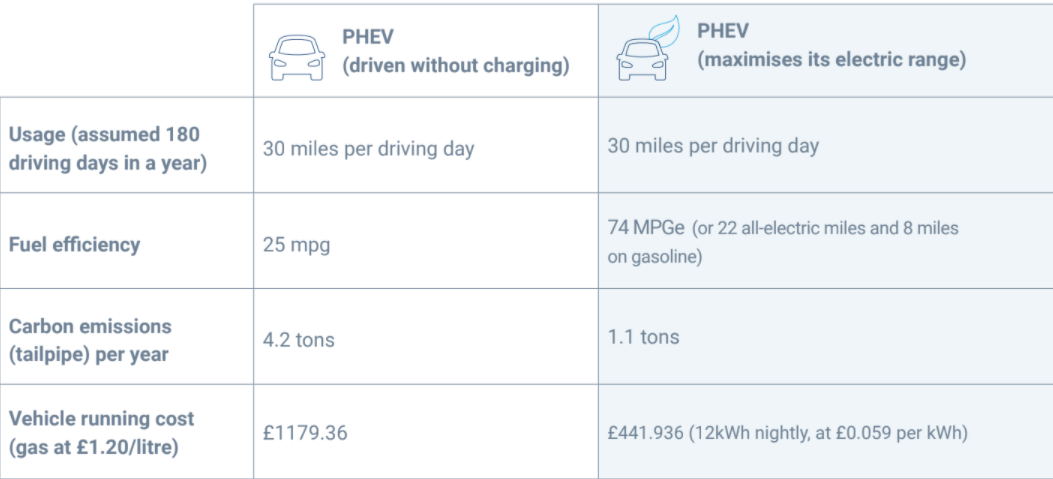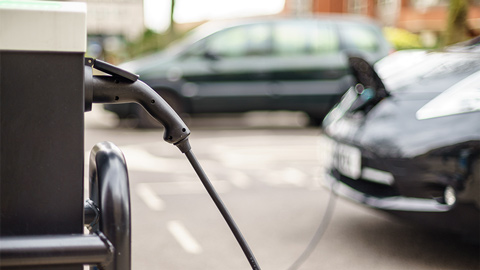Going Electric: What you need to know about EV fleet management
Published on April 7, 2020
Table of contents
- Perparing for a greener future
- Making the switch to electric vehicles
- EV adoption: Where to start
- Key factors to consider in an EV adoption strategy
- Introducing the electric vehicle suitability assessment
- Electric vehicle fleet management
- Optimising electric range through fuel efficiency measurement
- Reporting on charging activities
- Using real-time information to make decisions about your fleet
- Conclusion
Perparing for a greener future
Fleet adoption of electric vehicles (EVs) is on the rise. With government targets to cut carbon emissions, the continued push to reduce fleet costs, and the increasing choice and affordability of EVs, it’s likely that this trend will only continue.
The United Kingdom is making significant strides in support of electrification. Just last year, various government initiatives were established in favour of an electric vehicle uptake, including the Road to Zero strategy, the National Infrastructure Commission’s National Infrastructure Assessment (VIA) and the Automated and Electric Vehicles Act.
As the first of its kind, the Road to Zero strategy confirmed Government ambitions to see at least 50% — and as many as 70% — of new car sales to be ultra-low emission by 2030, alongside up to 40% of new vans.
“The Road to Zero Strategy sets out a clear path for Britain to be a world leader in the zero emission revolution - ensuring that the UK has cleaner air, a better environment and a stronger economy,” said Chris Grayling, Secretary of State for Transport.
“The coming decades are going to be transformative for our motor industry, our national infrastructure and the way we travel. We expect to see more change in the transport sector over the next 10 years than we have in the previous century.”
According to the Department for Transport, the Road to Zero strategy also includes a £400 million Charging Infrastructure Investment Fund to help “accelerate the roll-out of charging infrastructure by providing funding to new and existing companies that produce and install charge points.”
So with the Government making such a public push, there’s no doubt that now is the time for fleets to consider implementing an EV strategy.
Making the switch to electric vehicles
What does all this mean for fleets? As the move to zero-emissions gains traction at every level of government, private fleets will start to feel the pressure to also switch to EVs when their current fleet reaches the end of its service life.
Before switching over to electric vehicles, there are a number of important questions to consider:
- How do you transition a fleet to electric?
- Do all fleet vehicles need to be fully electric?
- How many electric vehicles should you buy, and when?
- Once you’ve completed the switch, how do you apply traditional fleet management techniques?
EVs also introduce new challenges to the fleet such as adding new metrics they have to monitor. Often, the biggest challenge is the increased complexity of billing and vehicle reporting for state of charge (SOC).
Luckily, telematics has the ability to provide a valid solution. From selecting the best fit electric vehicle for your fleet needs, to providing an open platform for monitoring both electric and conventional vehicles in one place, Geotab is supporting fleet managers in adapting to this new vehicle type.
EV adoption: Where to start
Let’s say your fleet is looking to switch one vehicle to electric. When beginning your EV adoption journey, it is important to answer three things about your current vehicle:
1. What is the maximum range that the vehicle completes?
2. What are my current costs for running the vehicle?
3. Where to dwell, and for how long?
By answering these three questions, you will have a clear understanding of the requirements for the new EV, beyond just matching a vehicle size.
Key factors to consider in an EV adoption strategy
Maximum range
Through looking at the maximum range a vehicle completes in one day, you are able to choose what kind of EV you require. Do you need a long-range battery EV with a range over 200 miles? Or will a short-range battery do the job? Is partial electrification with a plug-in hybrid best, given that you are driving 400 miles regularly in one day? Range anxiety is often cited as one of the main reasons fleets have not yet switched to EVs, as they do not want their drivers to be stranded without access to charging facilities. Analysing the maximum distance driven by a vehicle provides an immediate pass/fail gate when considering an electric vehicle.
Current running costs
Understanding the current costs associated with the vehicle you are looking to replace can help facilitate choosing an EV that will save you money in the future. The manufacturer’s suggested retail price (MSRP) and bid prices of electric vehicles are often higher than that of a conventional internal combustion engine vehicle. The higher price tag of an EV is often the second objection fleets have to adopting this technology.
However, this difference in price can often be overcome through the operational savings on the vehicle. It costs less to run an EV than it does to run a conventional vehicle. Understanding your expenses today, and comparing that to the future costs of the electric vehicle can help you understand if you will break even, or even reduce the fleet budget by switching to electric vehicles.
Vehicle dwell
The final question — “where does your vehicle dwell, and for how long?” — helps answer the third objection to electric vehicle adoption, which is charging. How many charging stations are required and where should they be placed? The purchase and implementation of charging infrastructure is often difficult to assess at the outset, with early adopters of EVs learning some valuable lessons.
It is important to implement an infrastructure strategy that ensures your fleet vehicles are able to charge to 100% during their dwell time, so your drivers can start every day with a full battery and a good understanding of their vehicle’s range. This may mean that for your first few EVs, you are able to charge them directly from a normal wall outlet. Or, you might want to install a dedicated charging station for each EV, with an understanding of how this infrastructure will be grown as you continue greening the fleet.
Since each fleet’s dwell time and location are unique, it’s critical to use your own fleet’s data when planning the infrastructure component of your EV adoption strategy.
Introducing the electric vehicle suitability assessment
Geotab helps you answer all three of these questions using your own fleet’s data in a simple to use report. The electric vehicle suitability assessment (EVSA) evaluates your current fleet and creates a multi-year procurement plan to help you electrify it. An EVSA provides all the information required to help ensure you are putting the best-fit EVs into your fleet — so you don’t end up adopting a vehicle that does not work for you.
Electric vehicle fleet management
Electric fleet management and traditional fleet management have many similarities, but at the same time, they’re very different. While you will want to continue monitoring traditional fleet metrics such as utilisation, there are brand new metrics to monitor with EVs, such as SOC, charging session details and for plug-in hybrids, electric miles versus
fuel miles.
Geotab provides a platform where you can monitor your EVs and conventional vehicles together. There are three distinct benefits to having everything under one roof:
1. Optimising electric range through fuel efficiency measurement
2. Reporting on charging activities
3. Using real-time information to make decisions about your fleet
Let’s take a closer look at how monitoring your EVs in this manner is key to fleet management today.
Optimising electric range through fuel efficiency measurement
The Geotab platform can help in many ways to optimise the range of your electric fleet. The first way is through reporting of kilowatt-hours per mile (kWh per mile), or alternatively, the fuel efficiency of your EVs. This allows you to compare the efficiencies of each vehicle and help adjust operational behaviour to increase this efficiency. Safe driving practices, such as smooth braking and smooth acceleration, can help increase the electric range of the vehicle. The larger the range of the vehicle, the less time that vehicle has to spend charging. This kWh per mile reporting makes it easy to measure fuel consumption by the electric vehicles as well. The Geotab platform reports this not only as kWh/mile, but also a MPGe. For your plug-in hybrids, a blended MPGe is reported in addition to the electric kWh/mile and conventional MPG. Being able to capture this fuel efficiency is key to understanding how your plug-in hybrids are being driven. Are they being driven as electric vehicles or as conventional vehicles?
To capture the true savings on carbon emissions and lower fuelling costs, your plug-in hybrids have to be maximising the electric distances that they are driving. Reporting on fuel efficiency is integral for hitting carbon reduction targets. See the following table as an illustration.
Comparison of a Mitsubishi Outlander PHEV (plug-in hybrid)
Driven without charging vs. electric range maximised.

In this example, maximising the electric range of the fleet vehicle results in:
1. 45% reduction in run costs
2. 73% less fuel used every day
3. 73% reduction in CO2 emissions
Reporting on charging activities
One of the biggest challenges fleet managers face with electric vehicles is reporting on charging activities.
Currently, there is a mix of ways that fleets can do this through charging station providers and electricity bills. However, this is only a partial solution.
For a true equivalency to conventional assets you need to be able to account for each kWh charged for each vehicle, same as you would with the number of gallons of petrol or diesel. The Geotab platform reports this for each vehicle as a record from a charging session, along with the location of that charging session, the length of charging session, the kw rate of the charging session, the starting SOC, the end of SOC, and the time of the session.
This allows a fleet to be able to fully allocate the costs of charging per vehicle, instead of per facility as with an electric bill.
In addition to knowing the electricity usage by asset, tracking the location of each charge will help understand how the vehicles charging are contributing to overall building load. With a record of charging events (by vehicle and at what kw rate), you can start to optimise charging to help lessen the building load during peak time.
A record of charging by asset shows you charging patterns for different vehicles and lets you measure plug-in compliance — another charging optimisation strategy. Using telematics data, you can understand when vehicles are charging and ensure that they are charging every day to maximise the electric range available to the driver. Plug-in compliance is one of the largest issues facing fleets, and can be obscured if charging is not recorded on a by-asset basis.
Using real-time information to make decisions about your fleet
The third benefit of having an all-in-one telematics solution for your electric and conventional vehicles is the ability to leverage real-time information on your electric vehicles to help optimise your fleet’s operating abilities. Geotab reports the live SOC of a vehicle, which can be partnered with the powerful MyGeotab rules engine to aid with plug-in compliance and charging optimisation.
Using the rules engine and real-time SOC, you are able to ensure plug-in compliance based on SOC. If the vehicles have a consistent route and use, you can set a rule to ensure it is charging when it is below the SOC required to complete their route the next day. This can help minimise vehicle downtime due to charging.
The live SOC also gives an indication of the range available on the vehicle, so an operation is able to react in real-time to developing situations and respond with a vehicle that has an appropriate level of charge.
The SOC also supports fleet pool management by giving an indication of vehicles that need to be charged. This ensures that a vehicle has enough charge when it is booked for a journey. Similar to the application of the rules engine above, if the vehicle is returned to a home base, using the SOC reading, a Geotab alert can be sent out to ensure the vehicle is plugged in and charging for the next user. This helps ensure that the EVs in a shared fleet pool application will have a high utilisation.
Conclusion
As electrification continues to become a priority to save fleets on fuel costs, and reduce carbon emissions, it is key to have a telematics platform that can provide all the necessary tooling to monitor your conventional vehicles and your electric vehicles. By having all your information in one place, you are empowering your fleet managers to optimise the fleet usage, and ensure that you are getting the maximum return on investment from your electric fleet. Geotab offers this platform to help you, and your fleet, continue adapting to the changing fleet world, and make the transition from conventional to electric smoother than ever before.
For more information on EV fleet management, please visit: https://www.geotab.com/uk/fleet-management-solutions/electric-vehicles/
Post Tags
About Geotab
Geotab is a global leader in connected vehicle and asset solutions, empowering fleet efficiency and management. We leverage advanced data analytics and AI to transform fleet performance, safety, and sustainability, reducing cost and driving efficiency. Backed by top data scientists and engineers, we serve over 55,000 global customers, processing 80 billion data points daily from more than 4.7 million vehicle subscriptions. Geotab is trusted by Fortune 500 organisations, mid-sized fleets, and the largest public sector fleets in the world, including the US Federal Government. Committed to data security and privacy, we hold FIPS 140-3 and FedRAMP authorisations. Our open platform, ecosystem of outstanding partners, and Marketplace deliver hundreds of fleet-ready third-party solutions. This year, we're celebrating 25 years of innovation. Learn more at www.geotab.com/uk, and follow us on LinkedIn or visit our blog.
© 2025 Geotab Inc.All Rights Reserved.
This white paper is intended to provide information and encourage discussion on topics of interest to the telematics community. Geotab is not providing technical, professional or legal advice through this white paper. While every effort has been made to ensure that the information in this white paper is timely and accurate, errors and omissions may occur, and the information presented here may become out-of-date with the passage of time.
Recent News

Going Electric: How UK fleets can successfully switch to EV
October 20, 2020

Fleet 2020: How UK fleets can lead the way to an electrified future
April 22, 2020

The Unseen Toll: Driver Stress and Road Safety
May 13, 2025

